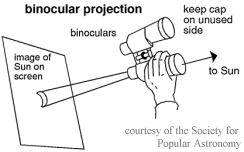Solar Eclipse in Efrat!
הַשָּׁמַיִם מְסַפְּרִים כְּבוֹד-אֵל וּמַעֲשֵׂה יָדָיו מַגִּיד הָרָקִיעַ
Psalm 19:2 The heavens declare the glory of God, and the firmament shows His handiwork

On Friday, the Astronomer got up early. He'd spent a restless night, tossing and turning and worrying lest the clouds block the view and spoil a rare chance to show off one of the more spectacular celestial events of the year, a partial solar eclipse.
The Astronomer had been uncharacteristically organized, sending out notices to the Efrat email list the night before, checking all his equipment, lining up his children to help him. I, the Astronomer's wife, kept a low profile and resolved to sweep up any pieces. Plus, our neighbor Batya was giving a shiur that morning and I didn't want to miss it, especially for something I considered rather pedestrian, a mere partial eclipse, a paltry 24% coverage. I'd skip it and see that the essentials (feeding kids breakfast, delivering children to school, being available to comfort the Astronomer should clouds run the whole plan amuck and he find himself alone on a street corner waiting for a patch of blue sky that would never come.
However, I had forgotten about the simple fact that, well, a solar eclipse, even a partial one, is really neat. Words like "WOW!" and "SO COOL!" come out of the mouth involuntarily. This was Becky's fault, really. She needed a ride to school and the Astronomer had seen fit to give her a pair of sun filters so she could admire the eclipse in the car on the way there. I was driving along, minding my own business, but it was just too much, having her there in the front seat, gawping up at the sun. So I pulled over the car, grabbed the glasses from her, and took a look.
Suffice it to say I oohed and aahed. Then I decided that everyone had to take a look at this. I mean, everyone was just driving around as though it was a regular Friday morning; probably they had no idea there even was a solar eclipse. Becky and I stayed there as long as we could, staring up with those funny glasses, but to my disappointment, though we garnered a few funny looks, no one stopped to ask what was so interesting. Perhaps they feared I would tell them, at length.
So we tried another tack. We picked up a few hitchhikers and Becky handed them the glasses. They oohed and aahed and asked questions and stared some more and oohed and aahed. One was a teacher, and I was tickled pink, thinking of how she was thinking of how she'd weave this wonder of the universe into her morning's lessons. I dropped Becky and the other hitchhikers at their school, then hurried to the street corner to watch the Astronomer at work before I'd have to rush off to shiur.
A happy, if modest, crowd had gathered around at the street corner, staring through filters or through the filtered telescope, or through pieces of those pinholed papers that show the eclipse's image onto a second paper. Everyone was very happy, everyone was asking questions, the Astronomer was in his element. Our own Sharon Katz, not, by her own admission, an early riser (oh, come on, it was well after 8AM!) had come especially to film the event and interview the Astronomer about eclipses and new moons and the molad. He explained (patiently, and not for the first or the second time) that the molad is not the visible new moon we Jews think of in connection with Rosh Chodesh, the new month. Rather, the molad is the conjunction of the moon and sun that happens every month. Usually, this conjunction doesn't result in an eclipse because the moon is either above or below the sun as their paths cross. Occasionally, however, the moon is right between the earth and the sun, blocking the earth's view of the sun, which we on earth experience as a total solar eclipse. More frequently, the conjunction is a partial one; that is, the moon blocks only a section of the sun, which we on earth see as a partial solar eclipse—only if we happen to look up (with our solar filters, of course).
In the shiur I attended later that morning (after I tore myself away from the excitement at the street corner), someone mentioned that the study of nature might lead to man's worshiping nature instead of nature's Creator. Instead of letting our learned teacher response, I butted in (still bubbling over with residual excitement) that today's celestial event, the partial solar eclipse, was an excellent example (imho) of the opposite: A person who studied nature might conclude, for example, that the sun—powerful, the source of our life—was worth of being worshiped. And yet, a simple observation of a regular phenomenon like a partial solar eclipse showed clearly that powerful as the sun is, a small, relatively insignificant object like the moon can block its light and its warmth. Moreover, the moon does so on a regular basis! Something else is in charge, something else is in control . . .
Sharon asked the Astronomer, "Are there really so many celestial events happening all the time, or do we just hear about them because we (Efratians) have you?" The Astronomer laughed and said, "There really are events happening all the time: You just have to know where to look."
Keep looking up!
Sharon's
blog 
and
video, featuring the Astronomer
And here's a link to the
Astronomer's own photos:

 Mars's name in English is for the Roman god of war, but its name in Hebrew, Maadim, denotes its pretty red (adom) hue rather than any military associations. And "opposition" with reference to celestial bodies simply means that the planet is at its closest and brightest for this particular orbit. So harmony reigns in the skies as well as on earth on Tu B'Shvat, and we can all relax.
Mars's name in English is for the Roman god of war, but its name in Hebrew, Maadim, denotes its pretty red (adom) hue rather than any military associations. And "opposition" with reference to celestial bodies simply means that the planet is at its closest and brightest for this particular orbit. So harmony reigns in the skies as well as on earth on Tu B'Shvat, and we can all relax.
 On Friday, the Astronomer got up early. He'd spent a restless night, tossing and turning and worrying lest the clouds block the view and spoil a rare chance to show off one of the more spectacular celestial events of the year, a partial solar eclipse.
On Friday, the Astronomer got up early. He'd spent a restless night, tossing and turning and worrying lest the clouds block the view and spoil a rare chance to show off one of the more spectacular celestial events of the year, a partial solar eclipse.






